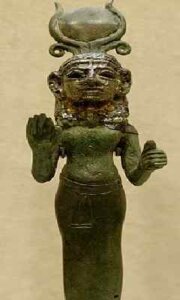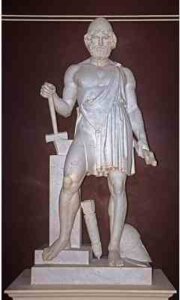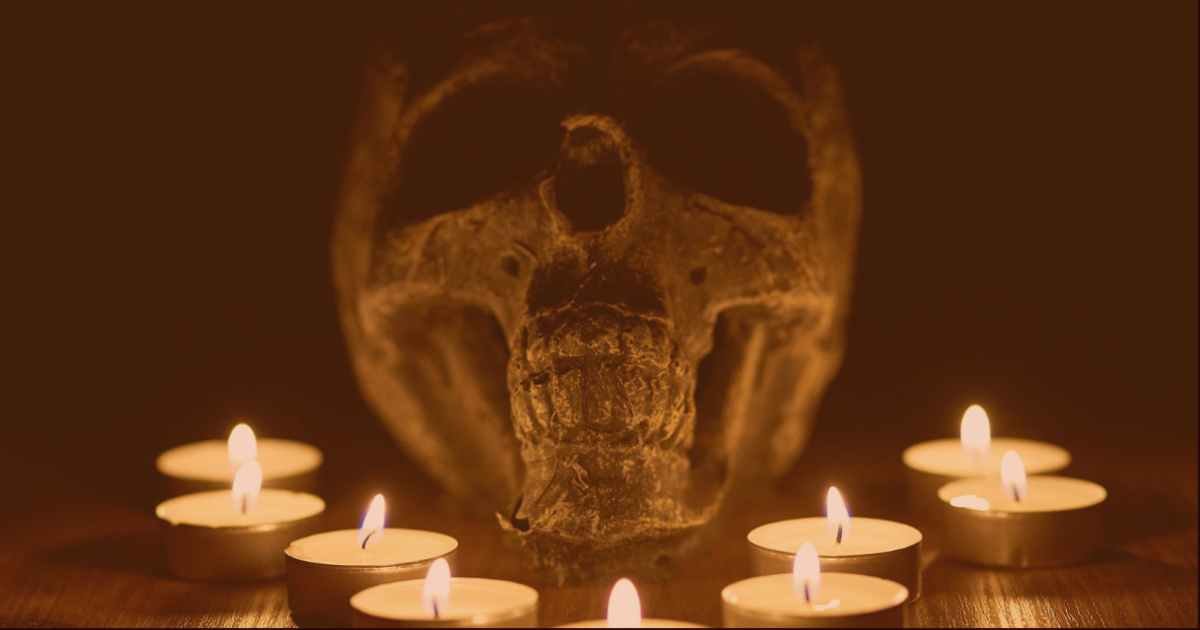John Milton’s presentation of the rebel angels in Paradise Lost, as they rise from the lake of fire and light on the fiery land of hell, is an impressive myth created mainly out of Biblical accounts in the Old Testament. In his presentation, Milton is seen as a devout, almost fanatical Puritan, who was also a poet with romantic imagination and myth making fancy. In the hierarchy of Hell, Milton presents Satan the chief of the order, and Beelzebub next to him both in rank and power. The rest of the angels in the degree of importance include Moloch, Chemos, Baalim, Ashtaroth, Astoreth, Thammuz, Dagon and such angels right down to Belial.
Milton follows the tradition or convention of Classical epics in creating a pattern of roll-call in introducing the rebel angels. The first to come was Moloch, the king of horror and violence, soiled with blood of child sacrifice. Next came Chemos, whose obscene idol was worshipped by the Moabites. He was followed by the evil spirits Baalim and Ashtaroth (the former being male deities, the latter, female). Milton goes on to mention Astoreth, the moon goddess, wo was worshipped by Sidonian virgins and then Thammuz, whose worshippers in Lebanon observed mourning rituals for his wounding. Dagon came next, his idol representing a sea monster, worshipped through the coast of Palestine. Then appeared Rimmon whose seat was in Damascus. Then the band of deities who were worshipped by the Egyptians as Osiris, Isis, Orus etcetra, appeared followed finally by Belial, the lowest of the fallen angels.While describing the construction of Pandemonium, Milton mentions two other rebel angels Mammon and Mulciber. While Mammon led the troop, who mined out gold and other metals for construction, Mulciber was the chief architect of the grand palace of Hell.
Two things are noticeable in the manner in which Milton makes up the hierarchy of Hell. The names and characteristics are mainly taken from the Hebrew Bible. Milton identifies the fallen angels with the various gods and goddesses worshipped by the different idolatrous nations. The ancient monotheistic Hebrews, worshipping Jehovah, had to live amidst these idol-worshipping people. Often, the monotheistic Hebrews got enticed by the heathen rituals and got involved in idol-worship with licentious and often homicidal orgies. Then, in the second half of describing the rebel angels, Milton turns to the inexhaustible storehouse of beautiful legends of the ancient Classical Age. Milton identifies these Pagan deities with the followers of Satan who fell along with him from Heaven.
Rebel Angels in Paradise Lost
Beelzebub
Beelzebub, according to Demonology, was the “Lord of the Flies”, worshipped by Philistines. The word “Beelzebub” represents the Assyrian lord of the high tower according to the Old Testament. He is also referred to as “the prince of demons” in Mark 3:22. In Paradise Lost Book 1, Milton calls him second in power and status to Satan himself. He is Satan’s “bold compeer”. As the epic unfolds, Beelzebub emerges as a practical spirit with keen foresight. Beelzebub feels subdued at their defeat and would have surrendered to God unconditionally had Satan not cheered him up by his fiery eloquence. Still, he knows the extent of the “dire event” and repents having lost the comfort of heaven. He apprehends that the future might have deadlier punishment in store for the rebel angels. Beside Satan’s proud assertive self, Beelzebub appears gloomy and visibly uncomfortable. His speeches, brief and impassioned, show him as an astute statesman and sagacious councillor advising moderation and caution.

Moloch
The first rebel angel to respond to Satan’s call and rise up from the lake of fire was Moloch. The name literally means “the king”. Moloch was a sun-god, worshipped with the sacrifice of children by means of fire. His idol was made of brass with the figure of a king and the head of a calf. He was worshipped by the Ammonites in Rabba, Argob, Basan, Arnon and other regions belonging to the Ammonites. Milton deliberately uses these proper names for the sonorous effect as well. Moloch ended up corrupting the wise king Solomon who built Moloch’s temple on Mount of Olives. Since then the beautiful valley of Hinnom turned into Gehenna, a living hell.
Milton describes Moloch as a symbol of violence and hatred. Throughout the book, Milton emphasises how these deities (who, according to Milton were originally Satan’s followers) corrupted men and turned them away from their real God Jehovah.
Chemos
Chemos was the god of the Moabites. He has also been identified with Bal-Peor. He was worshipped from Aroer to Nebo and the southmost Abarim along with Hesebon, Horonaim, beyond the valley of Sibma and Eleale to the Asphaltic Pool, or the Dead Sea. These places are intended to give an outline of the Moabite territory but Milton might have been a little obscure and inaccurate.
Milton goes on to describe how Chemos corrupted the “sojourners of Goshen”, or the Israelites. When the Israelites were journeying from Egypt to the Promised Land, the Moabite women enticed the Israelites to join in the sacrifices and obscene rituals for their deity Baal-Peor . Since the gods of the pagans were often fertility gods, the “worship” often involved sexual acts. Milton associates these rituals with the cult of Satan primarily because of his strong Puritan and Hebraic ethos. He further mentions that Chemos corrupted the mind of Solomon, just like Moloch, and got his temple built right next to the temple of Moloch on Mount of Olives. While Moloch is presented as the personification of hatred, Chemos is personified as lust.
Baalim and Ashtaroth
Baalim is the plural of “Baal” (meaning, Lord), referring to all manifestations of the sun-god worshipped by the Phoenecians and the Canaanites. The corresponding female deities, or consorts were known as Ashtaroth. Usually, these deities were worshipped by fertility rituals, a form of worship that was dismissed by Christianity and Judaism. Milton says that these gods had no fixed sexual identity and could transform from one form to another. According to him, they often made Israelites forget their real God, for which they were defeated in wars.

Astoreth
Astoreth (singular of Ashtaroth), or Astarte, was the moon-goddess of the Phoenecians. She was the equivalent of Greek Aphrodite. She has crescent shaped horns, shaped like the curved moon. She was worshipped by Sidonian virgins and also by people of Sion. Solomon was convinced by his beloved to build a temple for Astarte on the Mount of Olives.
Milton is clearly very critical of Pagan fertility rituals. Interestingly, these rituals glorified the feminine powers of nature, something that the Patriarchal sentiments of Puritanism could never approve of. Associating Astarte with Satan’s army puts Milton directly at war with the ancient religious practices and makes the post-modern reader question Milton’s lack of artistic tolerance and objectivity.

Thammuz
Thammuz (also known as Dumuzid) was a Mesopotamian god associated with shepherds, who was also the primary consort of the goddess Inanna (later known as Ishtar or Astarte). According to fables, Thammuz was injured and killed by a wild boar but was eventually revived. Worshippers believed that his wound renewed every year and flowed through river Adonis. His death and revival were celebrated every year in a festival of mourning ending in rejoicing. The festival of Thammuz was a vegetation or fertility cult corresponding with the “death” of the sun in the winter solstice and his revival in spring. Syrian women mourned for Thammuz; and the love story of Thammuz and Astarte generated sexual desire in women who ended up being “wanton” even on the porch of the sacred temple. Such passion and sexual desire, especially in women, could never get approval of Milton’s narrow Puritan spirit. Therefore, Milton readily ended up associating Thammuz with Satan as well since Thammuz’s worship created “wanton” desire in women.
Dagon
Dagon was the chief God of the Philistines and the worship of this pagan god dates back the third millennium BC. According to ancient mythology, Dagon was the father of Baal. The lower part of his body was fish (Dag means fish in Hebrew). The Philistines being a sea-faring people, it was natural that they should have a fish-god for worship. Dagon may also have been the provider of grain. So, Dagon was similar to many other idols in that he personified natural forces that had supposedly produced all things. A lofty temple was erected to him in Azotus. He was worshipped in Gath, Ascalon, Accaron and Gaza’s borders. After the “Ark of God” was seized by the Philistines and presented to Dagon as a trophy, his brute image was found mutilated the next morning.
Mammon
Mammon is presented by Milton as the personification of greed. Even before his fall, Mammon used to keep his eyes fixed on the pavements of heaven, made of gold. This made Mammon have a stooping figure and is referred to as the most “lewd” spirit. Mammon’s obsession with gold and riches makes him an expert to guide the rebel angels mine out gold and other expensive minerals for building Pandemonium. He later taught the trick of mining to human beings as well. Milton describes the earth as mother and finds the act of mining equal to digging into entrails of mother’s body.
Through the description of Mammon, Milton expresses his disapproval of man’s obsession with ornate material riches. This can also be seen as a Puritan stand against Roman Catholic preference for ornamental and richly decorated churches.

Mulciber
Mulciber is described as the architect of Pandemonium. Milton speaks of Mulciber with far less hostility that he does about other fallen angels. Mulciber was the architect of heavenly palaces as well. He was worshipped in ancient Greece as Hephaestus or in Rome as Vulcan, the god of fire, metalwork and forge. Milton says that the Greek people mistakenly thought that Vulcan was thrown down from Heaven by Jupiter while, in reality, he fell along with Satan in the “dubious battle”. The classical myth is seen as distorted version of the true events recorded in the Bible. In the Invocation itself, Milton had declared that his truth will rise above the Classical lore. In these cases, he attempts to do right that by disregarding and belittling classical mythologies.

Milton’s Rebel Angels: Puritanism in Myth Making
While the Hebraic zeal of the Puritan in Milton made him identify the fallen angels with these abominable gods of the idolaters, he is also able to communicate his instinctive enthusiasm in creating high poetry out of these Biblical references. The long roll of names, accompanied by graphic details may appear to be tedious and long winded to the uninitiated. However, aesthetic and intellectual delight demands a certain price and preconditioning of reader’s mind.
An interesting thing about Milton’s presentation of these rebel angels is the way he communicates his disgust for polytheism, idol-worship and any non-Christian form of worship. It is true that some of the rituals connected to deities like Moloch and Chemos are heinous and perverse, and deities like Belial are vicious to the core. However, most other rituals, especially in connection to Astoreth, Thammuz, Dagon and the like were rituals related to fertility and nature’s bounty. These agrarian gods and goddesses were worshipped by the tillers of the soil and the fishermen of distant seas. Milton’s dismissal of these gods as downright evil points at his intolerant spirit and lack of objective understanding of the spirit of worship that drove these men and women towards these gods. Milton, with his urban erudition could hardly appreciate the beauty of pagan nature worship and fertility rituals. Moreover, the pagan forms of worship which prioritized the “Feminine” forces as equally powerful and potent, was unconceivable to a Puritan Christian who had strong patriarchal ethos to abide by. His intolerance is seen when he presents Baalim and Ashtaroth, with their gender fluidity, as vicious, especially because, to a staunch Puritan, sexual transformation was vicious and forbidden.
Milton’s description of fallen angels is, therefore, not just a beautiful poetic wonder, but also an indicator of a certain “fixity” in Milton’s own mind. Ironically, he had associated “fixed mind” with Satan. However, despite these disturbing questions, especially relevant in today’s context, Milton stands out as the master of creating poetry out of even the most vicious entities, or at least what he considered to be the vilest spirits. The angels, though described as individuals, with special qualities different from each other, they become a single body of evil supporting Satan in his evil purposes. These angels become, as it were, concrete manifestations of abstract qualities which are considered to be vices by Milton, the “fixed” Puritan.
Watch Video Lecture on Rebel Angels
Additional Reading
Paradise Lost: Complete Synopsis of All Books (I-XII)
John Milton‘s “Paradise Lost” is a celebrated epic in English Literature. He transforms the Biblical account about the Fall of Man from Paradise into rich, illustrious and timeless poetry. Paradise Lost: Book I [Invocation: Milton asks the muse to sing about man’s first disobedience, the Forbidden Fruit, his exile from...
Read MoreSatan in Paradise Lost Book I : An Epic Hero Or A Repulsive Hypocrite
One of the primary questions that perplexes the readers of Milton’s Paradise Lost concerns the poet’s delineation of Satan, the chief of the Fallen angels. Throughout the first two or three books of Paradise Lost, it appears as if Satan is the hero of the poem. This is partly because...
Read MoreParadise Lost: Significance of the Invocation
John Milton, in his attempt to create an epic presentation of practically the whole act of creation and transgression of Man, amalgamates Christian faith with tremendous aesthetic competency. Following the elementary classical conventions, he does frame his work within an apparent structural boundary, but eventually surpasses it by his imaginative...
Read More












Thanks a bunch Mam..it really helped a lot